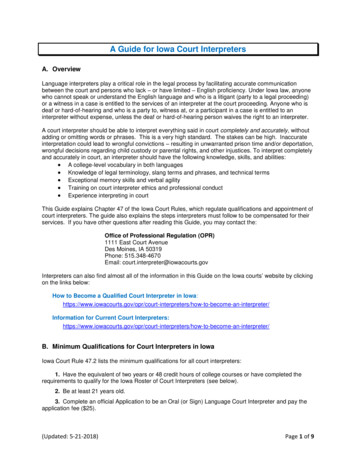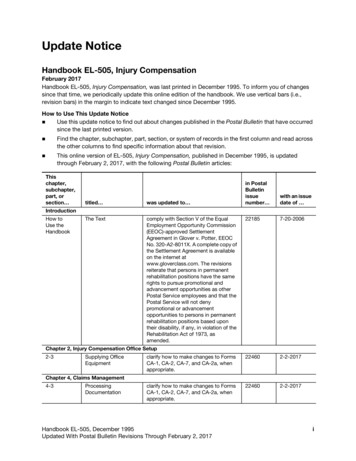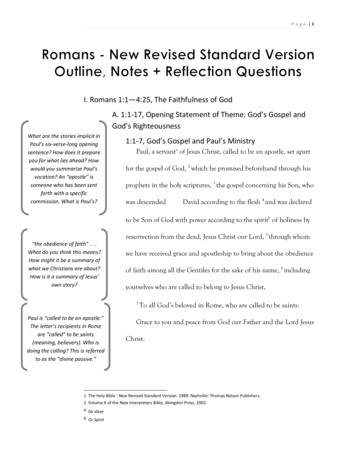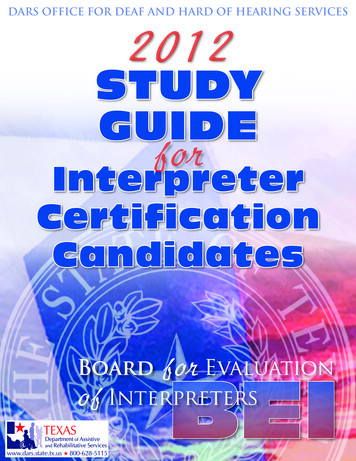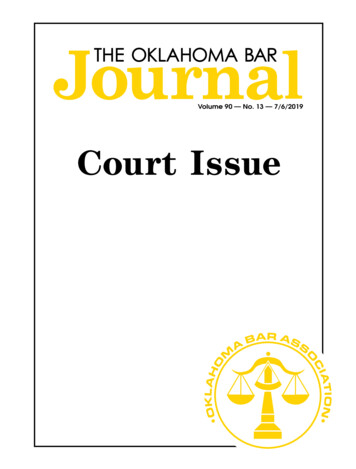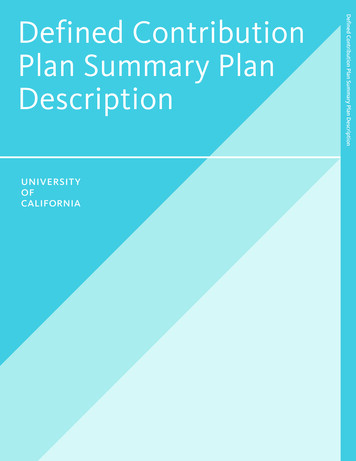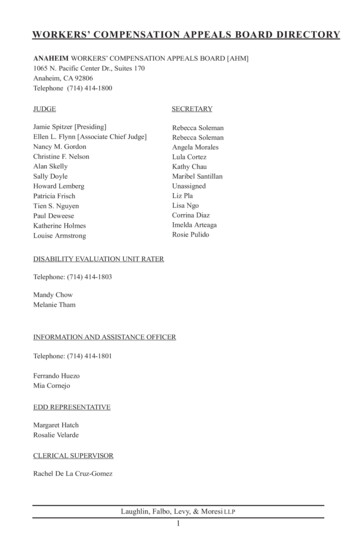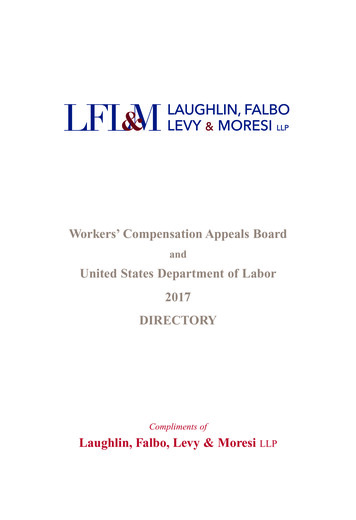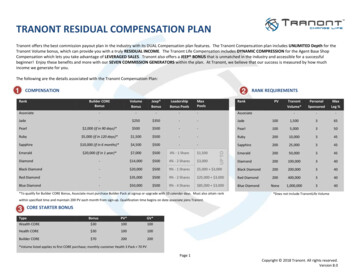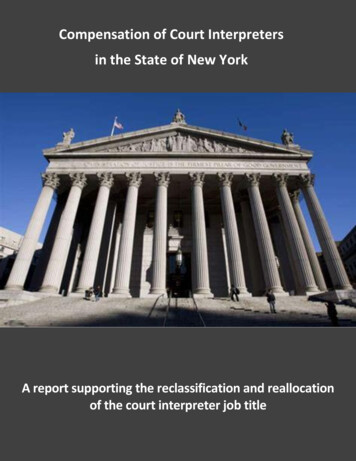
Transcription
Compensation of Court Interpreters in the State of New York0Compensation of Court Interpretersin the State of New YorkA report supporting the reclassification and reallocationof the court interpreter job title
Compensation of Court Interpretersin the State of New YorkA report supporting the reclassification and reallocation ofthe court interpreter job titleApril 2019
Compensation of Court Interpreters in the State of New YorkAuthorSandro Tomasi is a Spanish court interpreter for the New York State Unified Court System, acertified medical and social services interpreter (Washington State), and has worked as aninterpreter and translator since 1991. In early 2002, he was appointed by the NationalAssociation of Judiciary Interpreters and Translators (NAJIT) to its Title VI Committee to addressthe U.S. Department of Justice on LEP Guidance issues. He has chaired various conference andeducational committees for NAJIT, the American Translators Association, the now defunct LegalInterpreters and Translators Association, and is currently chair of NAJIT’s Advocacy Committee.He has spoken in dozens of interpreter and translator conferences and has led workshops forvarious state courts across the U.S. He has taught interpreter courses for the City University ofNew York’s Continuing Education Programs at Hostos College and Queens College as well as forthe New Mexico Center for Language Access. Mr. Tomasi is author of An English-SpanishDictionary of Criminal Law and Procedure, a contributing author of Diccionario Jurídico/LawDictionary, consultant for Dahl’s Law Dictionary and a contributor to Black’s Law Dictionary.AcknowledgmentsThe author sincerely thanks the following experts for their generous contributions to thedevelopment of this report:Mary Lou Aranguren is a certified court interpreter and has worked in criminal and civil courtsin California for twenty-five years. Ms. Aranguren was a leader in the movement by Californiainterpreters to gain employment rights and legislative director of the California Federation ofInterpreters (CFI) during the passage of the statute that established staff interpreter positionsand collective bargaining and statewide representation. She has served in numerous positionswith CFI as a field representative, statewide bargaining coordinator, and spokesperson incontract negotiations. Ms. Aranguren served on the State Bar of California’s Commission onAccess to Justice from 2010-2017. Appointed to the California Commission on JudicialPerformance by the Senate Rules Committee, she served as a commissioner from 2011 to 2018.Ms. Aranguren has a degree in Communications and Broadcast Journalism.Milena Calderari-Waldron has been a freelance interpreter since 2004. She is a WashingtonState Court certified Spanish interpreter and a certified interpreter for medical and socialservices by the Washington State Department of Social and Health Services (DSHS). She is also aDSHS certified English into Spanish Translator. Since 2013, she has been the elected Secretaryof Interpreters United Local 1671/AFSCME Council 28. She is a drafting member at the F43Technical Committee on Language Services and Products of the standards setting organizationAmerican Society for Testing and Materials. She is a current member of the AmericanTranslators Association (ATA) Interpreters Division Leadership Council, former Vice-president ofthe now defunct Washington State Court Interpreters and Translators Society (WITS) andformer board member of the ATA Chapter Northwest Translators and Interpreters Society(NOTIS). She is adjunct faculty at Bellevue College where she teaches interpreters. Prior tocoming to the United States, she was a Doctoral Fellow at Argentina’s National Council foriii
ivA report supporting the reclassification and reallocation of the court interpreter job titleScientific and Technological Research. Ms. Calderari-Waldron is a graduate of the University ofParis I Pantheon-Sorbonne with degrees in History and Archeology. She frequently presents oninterpreter ethics and business practices and is the author of several publications ininterpreting and archaeology.Robert Joe Lee worked for the New Jersey Judiciary from February 1978 until he retired at theend of 2008. After a few years of working as a Research Associate in the Probation Division andstaffing the Supreme Court Task Force on Interpreter and Translation Services, he managed thestate’s program to ensure equal access to courts for linguistic minorities from its inception in1985 until retiring. He has authored numerous publications on court interpretation andcoordinated the development of court interpreter certification tests in numerous languages. Incollaboration with staff of the National Center for State Courts and three other state judiciaries,he helped establish the Consortium for State Court Interpreter Certification in 1995 and ledNew Jersey to be a charter member. He chaired the Consortium’s Technical Committee andserved on its Executive Committee from 1995 to 2008. In retirement, he assists the state courtinterpreter certification testing programs (policy, development, revision, and rater training andsupervision), provides a variety of consulting services to state and federal judiciaries, conductsand publishes empirical research in the field, and makes presentations on court interpretationat colleges and professional conferences.
Compensation of Court Interpreters in the State of New YorkTable of ContentsEXECUTIVE SUMMARY . 1INTRODUCTION . 51. STATE-TO-FEDERAL SALARY COMPARISON . 61.1 JUDICIAL COMPENSATION . 61.2 JUDICIAL SUPPORT STAFF COMPENSATION . 71.3 FEDERAL COURT INTERPRETER COMPENSATION BENCHMARK . 72. COURT INTERPRETER TO COURT REPORTER COMPARISON . 102.1 PHONETIC- VERSUS CULTURE-BOUND TRANSLATION . 112.2 KNOWLEDGE, SKILLS AND ABILITIES (KSAS) . 112.3 QUALIFICATIONS AND TESTING . 122.4 COMPENSATION . 133. THE JOB OF COURT INTERPRETER AND CURRENT NYS JOB TITLE . 143.1 WHAT COURT INTERPRETERS DO . 143.2 COURT INTERPRETER KNOWLEDGE, SKILLS AND ABILITIES (KSAS) . 153.3 COURT INTERPRETER TESTING . 153.3.1 NYS COURT INTERPRETER TESTING . 163.3.2 WRITTEN AND ORAL TESTING . 163.3.3 TEST OUTCOMES. 173.4 OTHER FACTORS RELEVANT TO TITLE RECLASSIFICATION AND REALLOCATION . 183.4.1 COURT INTERPRETER CLASSIFICATION AS PROFESSIONAL . 183.4.2 EDUCATION. 193.4.3 SECOND LANGUAGE ACQUISITION. 203.5 DEFICIENCIES IN CURRENT TITLE . 204. CONCLUSION AND RECOMMENDATIONS . 234.1 FINDINGS . 244.2 RECOMMENDATIONS . 24APPENDIX 1 NYS COURT INTERPRETER JOB TITLE (1986) . 25APPENDIX 2 NYS COURT INTERPRETER JOB TITLE (1994) . 27APPENDIX 3 NYS COURT REPORTER JOB TITLE . 29APPENDIX 4 NYS SENIOR COURT REPORTER JOB TITLE . 32APPENDIX 5 CALIFORNIA COURT INTERPRETER KSAS . 33APPENDIX 6 NEW JERSEY COURT INTERPRETER KSAS. 35APPENDIX 7 NEW YORK COURT INTERPRETER/REPORTER KSAS COMPARISON . 37v
Compensation of Court Interpreters in the State of New YorkEXECUTIVE SUMMARY“No person in the United States shall, on the ground of race, color, or nationalorigin, be excluded from participation in, be denied the benefits of, or besubjected to discrimination under any program or activity receiving Federalfinancial assistance.” —Title VI, Civil Rights Act of 1964The Supreme Court of the United States has held that failing to take reasonable steps to ensuremeaningful language access for limited English proficient (LEP) persons is a form of nationalorigin discrimination.1 The United States Department of Justice’s guidance2 and subsequenttechnical assistance letters from its Civil Rights Division explain that court systems receivingfederal financial assistance, either directly or indirectly, must provide meaningful access to LEPpersons.Dispensing justice fairly, efficiently, and accurately is a cornerstone of the judiciary. Courtinterpreters are necessary to secure the rights of deaf, hard of hearing and LEP persons whocannot be fully protected in legal proceedings unless qualified interpreters assist them. To thateffect, the New York State Unified Court System (NYS UCS) has more than 300 full- and parttime court interpreters in 21 languages.3 Court interpreters work bi-directionally, from and intothe English language, using the three modes of interpreting: simultaneous, consecutive andsight. Language industry surveys show that interpreters are a highly educated majority femaleand majority immigrant workforce.The Federal Judiciary sets a benchmark for both quality and compensation. In 2008, the federalJudicial Conference (the national policy-making body for the federal courts) adopted a new“landmark standard” setting grade JSP-14 for federal staff court interpreter positions.Court interpreters in the New York State Unified Court System are paid substantially less thanthis federal benchmark. This pay disparity does not exist for other job titles in the New YorkState Unified Court System.1Lau v. Nichols, 414 U.S. 563 (1974).U.S. Department of Justice (2002). Guidance to Federal Financial Assistance Recipients Regarding Title VIProhibition Against National Origin Discrimination Affecting Limited English Proficient Persons, 67 Fed. Reg. 41 455.3New York State Unified Court System (2017). Ensuring Language Access: A Strategic Plan for Ensuring LanguageAccess in the New York Courts, p. 5.21
2A report supporting the reclassification and reallocation of the court interpreter job titleState-to-Federal Salary ComparisonSALARY RANGETITLENYS DIFFERENTIALNYSFederalMinSalaryMaxSalaryCourt Reporter 81,254 – 131,923 91,511 – 105,237- 11% 25%Court Clerk 69,852 – 99,057 49,297 – 86,879 42% 14%Court Officer 63,358 – 90,160 75,9614- 17% 19%Court Interpreter 60,245 – 85,886 120,580 – 156,758- 50%- 45%Court interpreter compensation is also not in proper relationship to similar job titles in Stateservice. The court reporter title, which is the closest group of professional employees tointerpreters, provides another point of comparison and illustrates another significant disparity.Despite similarities in the nature of the job and skills required, a non-supervisory courtinterpreter in the NYS UCS earns 26% less than a non-supervisory court reporter at the entrylevel and 35% less at the top of the salary range.Research conducted for this report confirms important facts that illustrate deficiencies in thecurrent job title and the unequal treatment of court interpreters:4 Advanced fluency in a second language — close to native speakers — is typicallyreached after between five and ten years of learning the language. The NYS Office ofCourt Administration does not recognize much less quantify the acquisition of a secondlanguage as a qualification for the court interpreter title. Though the NYS UCS job title only requires a high-school diploma, industry surveys showthat at least 86% of interpreters surveyed are, in fact, college graduates, post-graduatesor doctoral graduates. The single most important qualification that court interpreters must have — passing thecivil service exam (or the equivalent) — does not appear in the court interpreter jobtitle. Risk factors unique to court interpreting are not properly accounted for by the NYS UCS.Interpreters work in potentially violent, stressful and high conflict environments, whichhave been documented to cause burnout, depression and/or vicarious trauma.Number based on what a federal security court officer, a private contractor, would make at 36.52 an hour for 40hours a week times 52 weeks.
Compensation of Court Interpreters in the State of New York Court reporters share several KSAs with court interpreters but many of these KSAs donot appear in court interpreter job title. Indeed, the court interpreter KSAs — originallyissued in 1986 and unchanged in the 1994 version — neither reflect current industrystandards nor the actual qualifications required of New York’s staff court interpreters. Court interpreting is a more demanding profession than court reporting due to thedifference between the phonetic-bound translation performed by court reporters ascompared with the culture-bound translation performed by court interpreters as well asthe necessity of working in two languages rather than one. 55% of court reporting candidates pass the New York State Unified Court System’s civilservice exam whereas the pass rate for Spanish court interpreters is 10%. NYS UCS staff court interpreters are paid about half of what their federalcounterparts are compensated while the salaries for NYS UCS court reporter,senior court clerk and court officer are not only comparable to those of theirfederal counterparts but, in most cases, higher. While in the Federal Judiciary the compensation for the court interpreter title (JSP-14) isset higher than the court reporter title (comparable to JSP-12), the NYS UCScompensates the court interpreter title (JG-18) much less than the court reporter titles(JG-24 to 27). The salary range for JSP-14 is 120,580 – 156,758. In order for NYS court interpreters to be treated equitably and consistent with thetreatment of other job titles in NYS UCS, their salary grade would need to be reallocatedfrom JG-18 to JG-31.Based on these findings and the supporting information in this report, the followingrecommendations are respectfully submitted in order for NYS UCS staff court interpreters toachieve salary parity with their federal counterparts in accordance with NYS UCS practice forits other court employees as well as to reach a proper relationship with the similar job of courtreporting:1) Update and reclassify the job title for NYS UCS staff court interpreters to better reflecttheir unique qualifications and KSAs.2) Reallocate the salary grade for NYS UCS staff court interpreters from JG-18 to JG-31.It is possible that the stark disparity in NYS UCS staff court interpreters’ compensation is basedon an inadequate assessment of the skills, knowledge, experience and qualifications actuallyrequired to provide equal access to justice for all. It is noteworthy that in addition to beingmade up of a majority immigrant and majority female workforce, the work performed isinherently associated with immigrants and LEP populations. Discrimination is often expressed3
4A report supporting the reclassification and reallocation of the court interpreter job titledifferently against foreign nationals than it is against people born in the United States;discrimination on the basis of actual or perceived English-language ability, bilingualism, andaccent, is a common method of subordinating immigrants.5The New York State Unified Court System should also consider the inherent risk of setting suchdisproportionate compensation policies for a single class of employees insofar as it has adiscriminatory effect. When salaries are too low, only those with means or those who have ahigh earning spouse or partner can accept a post. Such practice negatively affects recruitmentand retention, as well as the diversity of the workforce and the institution by discriminatingagainst those who are well qualified and interested in serving, but unable because of financialhardship.6 Court interpreting then becomes more a hobby than a viable profession reinforcingnegative stereotypes for a majority female workforce.“It shall be an unlawful employment practice for an employer to fail or refuseto hire or to discharge any individual, or otherwise to discriminate against anyindividual with respect to his compensation, terms, conditions, or privileges ofemployment, because of such individual’s race, color, religion, sex, or nationalorigin.” —Title VII, Civil Rights Act of 19645Jasmine B. Gonzales Rose (2014). Race Inequity Fifty Years Later: Language Rights Under the Civil Rights Act of1964. Alabama Civil Rights & Civil Liberties Law Review, vol. 6, pp. 167–212.6Maron v. Silver, 14 N.Y.3d 230, 263 (2010).
Compensation of Court Interpreters in the State of New YorkINTRODUCTIONCourt interpreters play a fundamental role in the administration of justice by ensuring access tothe courts for deaf, hard of hearing and limited-English proficient (LEP) persons.7 Ensuringlanguage access to the courts by providing professional interpreters goes to the core values ofthe New York State Unified Court System — fairness, equal justice, unfettered access, andpublic confidence and trust in the judiciary.8This report reviews the New York State Unified Court System’s policies with respect toclassification and compensation of employees working in the court interpreter title. Thefollowing questions are explored: In view of the principle that employees in state titles should be compensated similarly toequivalent titles in the U.S. District Court, how does the current rate of compensationfor staff interpreters in the New York State Unified Court System compare to theircounterparts in the federal courts in the New York region? In view of the principle that New York State Unified Court System titles that are similarin their professional qualifications and duties should be compensated similarly, howdoes the compensation of court interpreters in the NYS UCS compare with their closestprofessional counterpart, court reporters? In view of the similarity of the professions of court interpreters and court reporters, howdo the qualifications, knowledge, skills, abilities and duties of these two indispensablegroups of employees compare to one another?This report answers all those questions and concludes with findings and recommendations.7New York State Unified Court System (2018). Court Interpreter Manual and Code of Ethics, p. 1.New York State Unified Court System, supra note 3 at 9. See also New York State Unified Court System (2011).Court Interpreting in New York - A Plan of Action: Moving Forward, pp. 9–10.85
6A report supporting the reclassification and reallocation of the court interpreter job title1. STATE-TO-FEDERAL SALARY COMPARISON1.1 Judicial CompensationThe Commission on Judicial Compensation determined in 1999, 2011 and again in 2016 that theappropriate benchmark for the New York State Judiciary is the compensation level of theFederal Judiciary. The reasoning behind the Commission’s recommendations is succinct:The Commission recognizes the importance of the New York State Judiciary asa co-equal branch of government and recognizes the importance ofestablishing pay levels that make clear that the judiciary is valued andrespected. The Federal Judiciary sets a benchmark of both quality andcompensation — New York should seek to place its judiciary on par.9The proper adjustment of salaries has implications far beyond fairness to individual judges. Asthe New York Court of Appeals recognized, if salaries are too low, “only those with means willbe financially able to assume a judicial post, negatively impacting the diversity of the Judiciaryand discriminating against those who are well qualified and interested in serving, butnonetheless unable to aspire to a career in the Judiciary because of financial hardship thatresults from stagnant compensation over the years.”10By anchoring the compensation benchmark for the New York State Judiciary to thecompensation level of the Federal Judiciary, the Commission succeeded in establishingstandards for compensation levels through a fair, independent, and rational process. In 2016,NYS judges received a salary increase based on their salary comparison to federal judges withadditional raises recommended.11 Between 2011 and 2018, judges’ salaries in the New YorkState Unified Court System were increased between 53% to 54%.129Lawrence K. Marks (2015). Submission to the 2015 Commission on Legislative, Judicial and ExecutiveCompensation, p. 7.10Maron v. Silver, supra note 5.11The state Commission on Legislative, Judicial, & Executive Compensation approved a set of recommended payraises for Supreme Court judges to nearly 193,000 a year on April 1, 2016 that would be matched to those offederal district judges with likely salaries of about 207,000 by 2018, depending on cost of living dges-article1.246586112Susan DeSantis (April 03, 2018). “Salaries of NY State Supreme Court Justices Now on Par With Federal CourtJudges” in New York Law Journal. See also SEEthroughNY, Payrolls. Branch/Major Category, State - Judicial.Supreme Court Judges: 135,700 (2011); 208,000 (2018) 53.28%. Lower court judges: 125,600 (2011); 193,500 (2018) 54.06%.
7Compensation of Court Interpreters in the State of New York1.2 Judicial Support Staff CompensationCurrently, NYS salaries for court reporter (JG-24 and JG-27), senior court clerk (JG-21) and courtofficer (JG-19) are not only comparable to those of their federal counterparts but, in mostcases, higher.13 In contrast, NYS court interpreters are paid about half of what their federalcounterparts are compensated.SALARY RANGETITLENYS DIFFERENTIALNYSFederalMinSalaryMaxSalaryCourt Reporter 81,254 – 131,923 91,511 – 105,237- 11% 25%Court Clerk 69,852 – 99,057 49,297 – 86,879 42% 14%Court Officer 63,358 – 90,160 75,96114- 17% 19%Court Interpreter 60,245 – 85,886 120,580 – 156,758- 50%- 45%Table 1: Salary Comparison for Comparable State and Federal PositionsThis stark disparity in compensation is not based on a valid assessment of the skills, knowledge,experience and qualifications actually required to provide this critical service in the judicialsystem. Moreover, given that other positions in the New York State Unified Court System arecompensated in line with or above federal court compensation, the disparate treatment ofcourt interpreters gives the appearance of singling out a class of employees. This presents a riskinsofar as it has a discriminatory effect on court interpreters, most of whom are women andimmigrants.1.3 Federal Court Interpreter Compensation BenchmarkOne of the key factors that drives the compensation of many job types is the degree to whichthe work is viewed to constitute a profession with standards of performance that must bedemonstrated on a valid and reliable certification exam rooted in the profession’s documentedknowledge, skills and abilities (KSAs). Court interpretation is a profession that has been evolvingfor almost four decades, maturing from a service sometimes viewed as a necessary evil to aprofession on par with long-established professions such as court reporting. Many studies have13Federal “locality” rates in the NY-NJ-CT-PA region for Court Reporter (CR Level 1 – CR Level 4); Court Clerk (CL 25– CL 26); and Court Interpreter (JSP 14). NYS salaries include a 4,200 “location” pay.14Number based on what a federal security court officer, a private contractor, would make at 36.52 an hour for40 hours a week times 52 weeks.
8A report supporting the reclassification and reallocation of the court interpreter job titleshown how up through the early 1980s court interpreters were often viewed and treated asglorified clerical personnel who were asked to do a job that “any bilingual person” couldperform — with a corresponding low compensation. There were few standards and the fewthat existed were not based on empirical studies of the actual KSAs that the job entails. Therewas very little professional training available in either academic or non-academic contexts andno strong professional associations of court interpreters to promote professionalism.15That state of affairs began to end when, after Congress passed the Court Interpreters Act of1978, the Administrative Office of the United States Courts (AOUSC) embarked on developing acertification exam based on a robust study of the KSAs of court interpretation in the federaltrial courts. An interdisciplinary team of experts was assembled that traversed the country,conducting a thorough investigation of what judges and other legal professionals expected acompetent interpreter to do, and then developed a certification process that would yieldprofessionals who have demonstrated the ability to perform those KSAs.16The impact of the development of the Federal court interpreter certification exam had asignificant impact on compensation. The best summary is provided by González et al.:In sum, the impact federal certification had on the professional status of courtinterpreters in an area that traditionally had been highly resistant to changewas remarkable. The Government Service (GS) level of court interpreters priorto 1978 was 5 to 7, which translated to approximately 10,00 to 14,000 perannum. This pay level doubled after implementation of Public Law 95-539,when the starting salary for certified staff interpreters was elevated to GS 10,or 26,261 to 34,136 per year. An additional pay rate was instituted in 1985,which significantly increased both daily contractor rates — from 175 to 210per day — and staff rates — to an entry level of GS 10 to 13. In 2000, the dailycontractor pay rate was raised to 305 per day, while the staff rates increasedto an entry level of JSP 11 to 14, or 57,408 to 125,695 per year. In 2010,daily contractor rates were at an all time high of 388 per day , but staffstarting pay remained in JSP 11 to 14 range . Clearly, the value of thelinguistic and interpreting skills for federal interpreters has increasedtremendously over time.1715To see the level of professionalism in one nearby state in the early 1980s, see the final report of the New JerseySupreme Court Task Force on Interpreter and Translation Services, EQUAL ACCESS TO THE COURTS FOR LINGUISTICMINORITIES. Trenton: Administrative Office of the Courts, 1985, especially pp. 82ff. and background reports 3, 79, 12, 15, 16 and 22. For a historical overview, see Chapter 4, “The Profession of Court Interpretation,” in RoseannDueñas González, Victoria E. Vásquez and Holly Mikkelson, FUNDAMENTALS OF COURT INTERPRETATION:THEORY, POLICY, AND PRACTICE. Second edition. Durham: Carolina Academic Press, 2012.16Detailed descriptions of this massive endeavor are available in Etilvia Arjona, “The Court Interpreters TestDesign,” in L. Elías-Olivares, E.A. Leone, R. Cisneros and J.R. Gutiérrez, eds. SPANISH LANGUAGE USE AND PUBLICLIFE IN THE UNITED STATES. Berlin: Mouton de Gruyter, 1985. pp. 185-200; Chapter 46, “Federal Certification,” inGonzález et al., supra; and Seltzer v. Foley, 502 F. Supp. 600 (S.D. NY 1980).17Roseann Dueñas González, Victoria Vásquez, and Holly Mikkelson (2012). Fundamentals of Court Interpretation:Theory, Policy and Practice, 2nd ed., p. 173. Durham, N.C.: Carolina Academic Press.
Compensation of Court Interpreters in the State of New YorkIn 2008, the Judicial Conference of the United States (the national policy-making body for thefederal courts) adopted the following policy as recommended by its Committee on JudicialResources:Noting that staff court interpreter positions are highly specialized and presentunique challenges for fitting into the new CPS salary progression policy due tothe difficulties in making meaningful distinctions on the fundamentalelements of the interpreters’ work, the Committee recommended that theConference approve the conversion of the staff court interpreter positionfrom the CPS to the JSP, effective October 13, 2008. It also recommended thecreation of a JSP landmark standard with a target grade of JSP-14 for all staffcourt interpreter positions and the establishment of a grade JSP-15 forsupervisory court interpreter positions. The Conference adopted theCommittee’s recommendations.18Recent postings of job vacancies in the United States District Courts state that the salary rangefor the court interpreter position is JSP 11-14. However, a study published in 201619 found thatfederal district courts in the New York/New Jersey region hire court interpreters at the JSP-14level because this is the entry-level posi
the English language, using the three modes of interpreting: simultaneous, consecutive and sight. Language industry surveys show that interpreters are a highly educated majority female and majority immigrant workforce. The Federal Judiciary sets a benchmark for both quality and compensation. In 2008, the federal
